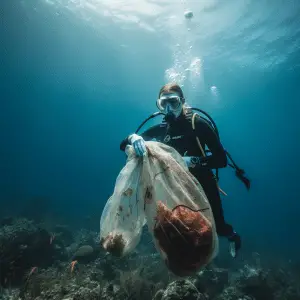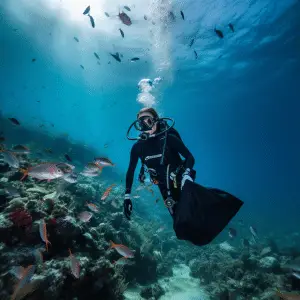Saving the oceans isn’t just for activists anymore! Here, we’ll explore options for dive equipment that minimize environmental impact. From biodegradable wetsuits to eco-friendly fins – discover how to dive with a conscience.
Traditionally dive gear was made from materials that damage marine ecosystems. But with increased awareness of sustainability, companies are now producing eco-friendly alternatives. For example, wetsuits made from natural rubber instead of neoprene reduce pollution and biodegrade.
Also, snorkels and masks are now made from recycled materials like post-consumer plastics or discarded fishing nets. This reduces waste in our oceans and gives materials a second life, instead of ending up in landfills.
Additionally, fins can be sustainably produced too! Fins from recyclable plastics or even plant-based materials like algae-based compounds perform well underwater and reduce our carbon footprint.
Pro Tip: When searching for eco-friendly dive equipment, look for certifications like the BlueSign label or products made from recycled or renewable materials. Making these choices lets you enjoy diving and protect fragile marine ecosystems.

Importance of eco-friendly alternatives for dive equipment
Diving’s a popular adventure – and it’s getting more so. To save the sea, eco-friendly dive equipment is essential. Non-eco gear has long life-spans and releases toxins into the ocean. Plus, making it adds to carbon emissions. To counter this, recycled materials now make dive gear. Companies use these to reduce plastic waste and protect resources. Furthermore, new designs and tech make gear stronger with less environmental impact.
Good news: eco-friendly dive gear is as good as any other! It’s tested to make sure it meets industry standards for performance and safety. With it, divers can enjoy their dives and help the planet.
Important to know: 8 million metric tons of plastic enter the ocean each year, says The Ocean Conservancy.
Overview of current environmental impact of dive equipment
The environmental repercussions of diving gear, such as masks, tanks, and wetsuits, are an important issue in today’s world. Non-biodegradable materials like plastic and neoprene are commonly used in their production, leading to pollution and damage to marine ecosystems. Additionally, certain components may contain hazardous chemicals like PVC and lead-based paints. And, there’s the unnecessary energy consumption associated with making these items.
Nevertheless, eco-friendly alternatives exist! Companies are now making dive gear from recycled plastics or natural rubber, thus reducing dependency on non-biodegradable materials. This contributes to a more sustainable, circular economy.
Awareness has grown about the environmental impact of dive equipment. This has motivated both manufacturers and divers to find alternative options that don’t harm nature. Innovative materials and sustainable production practices are being used to ensure that diving is an eco-responsible activity.
Research and development in eco-friendly dive equipment
Eco-friendly dive equipment is making great progress. Let’s take a look at some notable developments:
- Biodegradable wetsuits are now available. They break down naturally.
- Reusable diving masks reduce waste.
- Eco-conscious buoyancy aids are constructed with recycled materials.
- Coral-friendly sunscreen does not harm marine life.
These show commitment to reducing the ecological impact of traditional diving equipment.
Research is taking place on eco-friendly dive tanks and regulators.
Supporting eco-friendly initiatives is essential for manufacturers and divers. Choosing equipment that combines performance and conservation is key.
Be part of this movement towards eco-friendly dive equipment. Join us in embracing these innovations and helping to protect our oceans. Together, we can enjoy the beauty beneath the surface.
Types of eco-friendly alternatives for dive equipment
When it comes to dive equipment, there are green alternatives. These are not only good for the environment, but also give divers high-quality gear. Let’s take a look!
Eco-Friendly Dive Equipment:
- Wetsuits – Plant-based Neoprene
- Regulators – Stainless Steel Regulators
- Fins – Recycled Plastic Fins
- Masks – Silicone-Free Masks
- Weights – Bismuth Weights
Other options include biodegradable sunscreen and reusable water bottles instead of single-use plastic ones.
Sarah, a diver, changed to a plant-based neoprene wetsuit and found her underwater experience improved. Not only was she comfortable, but she also felt proud knowing her choice was helping marine ecosystems.
If we choose eco-friendly dive equipment, we can make a positive difference while preserving our planet’s oceans. So next time you dive, why not opt for sustainable options? It will benefit you and the environment!
Benefits of using eco-friendly dive equipment
Using eco-friendly dive equipment has many benefits. It can help prevent damage to marine ecosystems. It also reduces waste and pollution in underwater environments. Plus, it contributes to saving endangered species and their habitats. Moreover, divers become more aware of the importance of protecting our oceans. Aside from that, these alternatives ensure a responsible and conscious approach to diving.
By using eco-friendly dive equipment, divers can help protect marine life. Not only that, it gives a fulfilling diving experience and supports sustainable tourism. It can also maintain the biodiversity of underwater ecosystems for the future.
Natalia Molchanova, a freediving champion, is a great example. She increased awareness about eco-friendly dive equipment and promoted sustainable diving practices. Her dedication inspired divers around the world to protect our oceans.
To conclude, eco-friendly dive gear is necessary to keep our aquatic environments safe. Let’s join forces for this noble cause and make a positive difference through responsible diving.
Challenges and considerations in adopting eco-friendly dive equipment
Adopting eco-friendly dive equipment comes with some tough choices. These include:
- Availability: It’s hard to find these alternatives in dive shops.
- Cost: Eco-friendly gear can be more expensive than traditional options.
- Performance: It must meet diving needs effectively.
- Durability: It must last in harsh underwater conditions.
- Education & Training: Divers must learn how to properly use and maintain this gear.
- Resistance to Change: Some divers may be hesitant to switch to eco-friendly alternatives.
Research and development into alternative materials like recycled plastics and natural fibers could help create more sustainable options.
Here’s a story that shows the importance of eco-friendly dive equipment:
A group of experienced divers saw coral bleaching due to climate change. This inspired them to find ways to help marine conservation efforts. They invested in eco-friendly dive gear and shared it with other divers. This not only lowered their ecological footprint, but also encouraged others to do the same.
Where to find and purchase eco-friendly dive equipment
On the hunt for eco-friendly dive gear? Here’s a guide to help you locate and buy green products!
- Local Dive Shops: Check out the nearest dive shop and ask about their eco-friendly offerings. They might have biodegradable wetsuits or coral-safe sunscreen.
- Online Retailers: Look for websites that specialize in sustainable dive equipment. They often stock recycled fins, organic wetsuits, and more.
- Eco-Friendly Brands: Look out for brands that prioritize sustainability. They invest in research and innovation to create high-quality and green products.
- Second-Hand Options: Buy pre-owned dive gear from reliable sources. This reduces waste and gives older items a second life. Check online marketplaces or dive clubs for second-hand options.
Organizations also offer rental services for eco-friendly dive gear. This lets divers minimize their carbon footprint by using gear for a short time.
Pro Tip: Read product descriptions to make sure they meet your eco-requirements before buying.

Conclusion
Growing worries over the environmental effects of dive gear have divers on the lookout for eco-friendly options. These can lessen harm to marine ecosystems while supporting sustainable diving. By selecting equipment made of recycled materials or featuring modern technologies, divers can help the environment.
Eco-friendly wetsuits are one such option. Traditional wetsuits use neoprene, a non-renewable material. But plant-based materials like natural rubber and bamboo are used for eco-friendly wetsuits, thus reducing their carbon footprint. Plus, some brands recycle old wetsuits into new ones, further helping sustainability.
Other dive gear has eco-friendly alternatives too. For instance, buoyancy control devices (BCDs) can be made of recycled materials or bio-based plastics instead of petroleum-based ones. Dive fins can also be produced from recycled plastics or even biodegradable materials without sacrificing performance. Divers can still enjoy underwater adventures while minimizing their environmental impact by opting for these greener alternatives.
Pro Tip: When thinking of eco-friendly dive equipment, it’s vital to do in-depth research and pick products certified as green by reputable organizations such as Blue Flag or Green Fins. This ensures you get quality gear that truly matches your sustainable values and aids marine conservation efforts.
Frequently Asked Questions
1. Are there any eco-friendly alternatives for dive equipment?
Yes, there are several eco-friendly alternatives available for dive equipment. Manufacturers are now producing gear made from sustainable materials to reduce environmental impact.
2. What are some examples of eco-friendly dive equipment?
Examples of eco-friendly dive equipment include wetsuits made from recycled materials, fins crafted from biodegradable materials, and snorkels and masks made from sustainably sourced natural rubber.
3. Where can I find eco-friendly dive equipment?
You can find eco-friendly dive equipment at specialty dive shops that prioritize sustainable products. Additionally, many online retailers now offer a wide range of eco-friendly options.
4. Are eco-friendly dive equipment options as durable as traditional gear?
Yes, eco-friendly dive equipment options are designed to be just as durable as traditional gear. Manufacturers understand the importance of durability in diving equipment and ensure that eco-friendly alternatives meet the same standards.
5. How do eco-friendly dive equipment choices benefit the environment?
Choices benefit the environment by reducing waste, utilizing sustainable materials, and supporting companies that prioritize conservation efforts. By choosing eco-friendly options, divers can contribute to the preservation of marine ecosystems.
6. Are there any certifications or labels to look for when purchasing eco-friendly dive equipment?
Yes, there are certifications and labels to look for when purchasing. Look for certifications like “BlueSign,” indicating sustainable production processes, and labels like “OceanPositive” that highlight products made from recycled materials.
